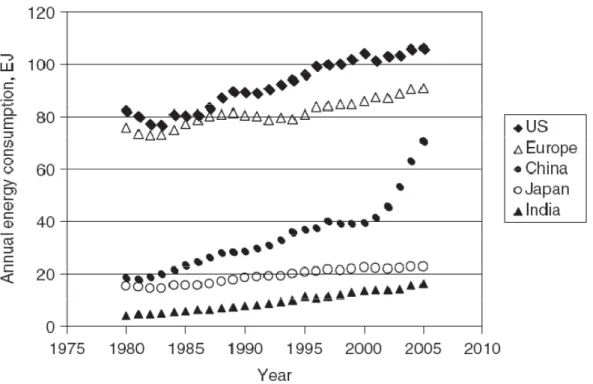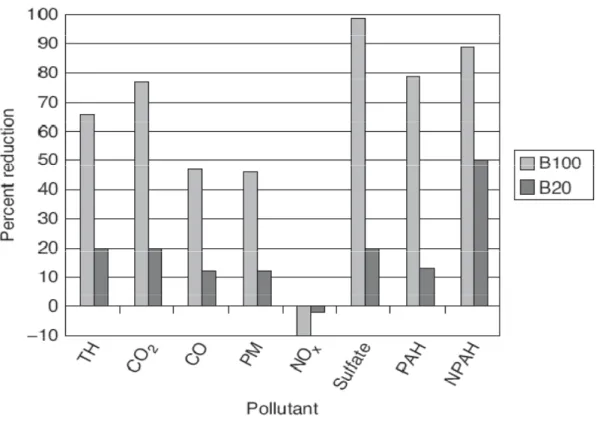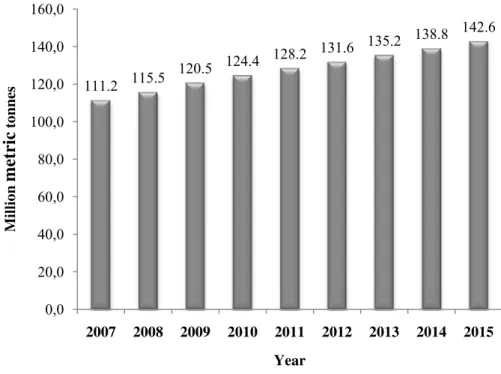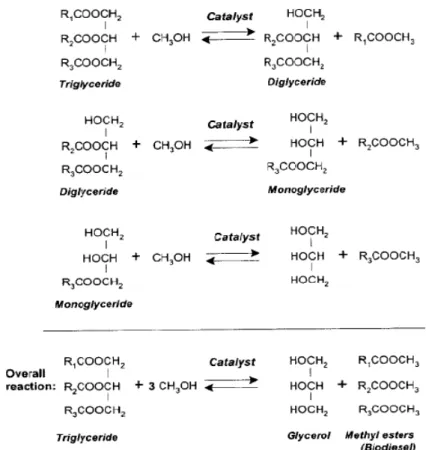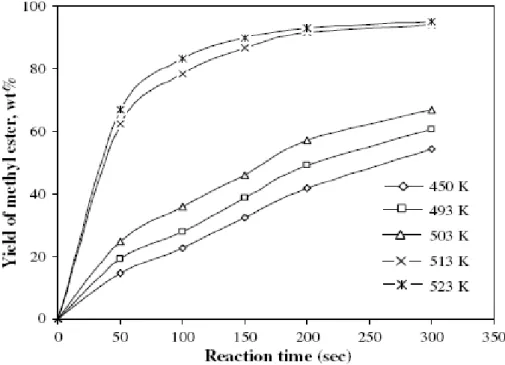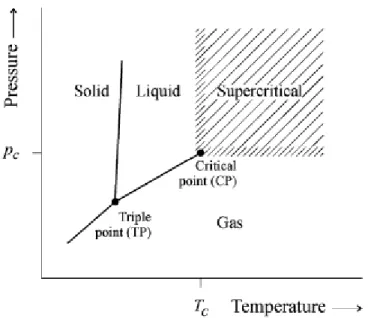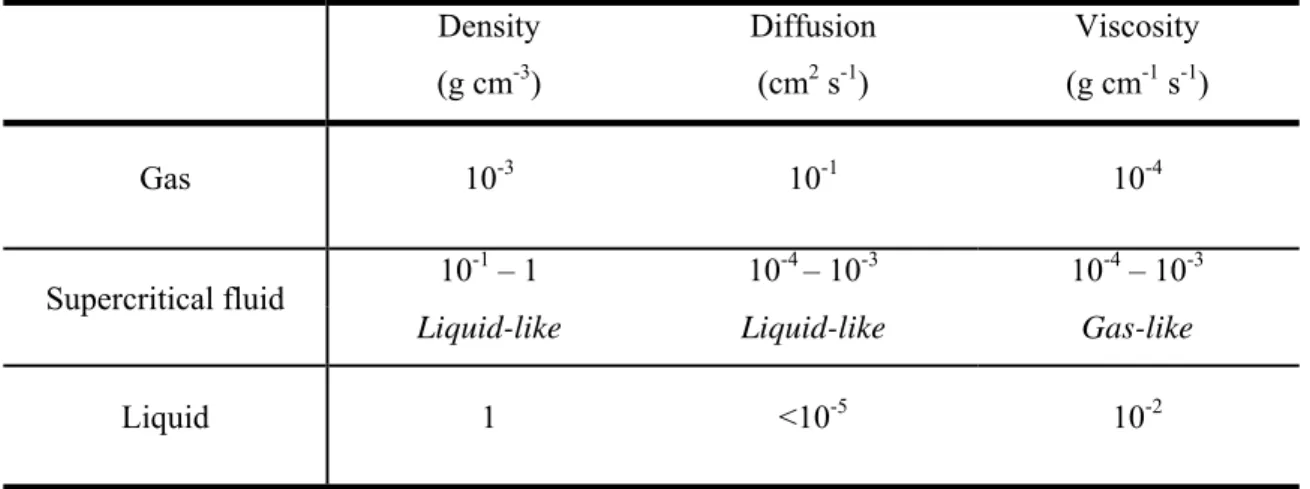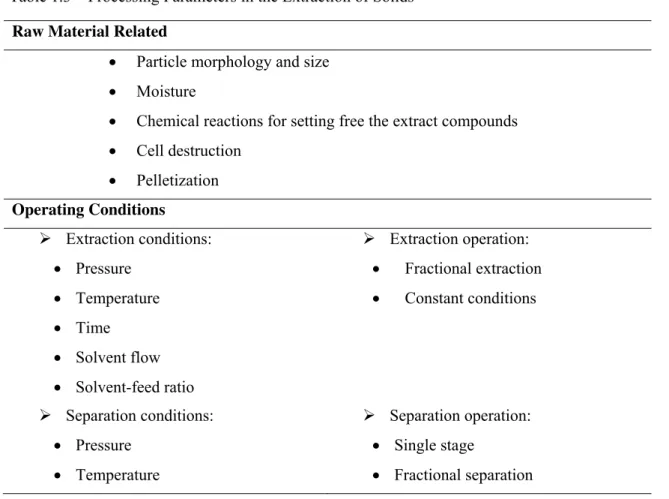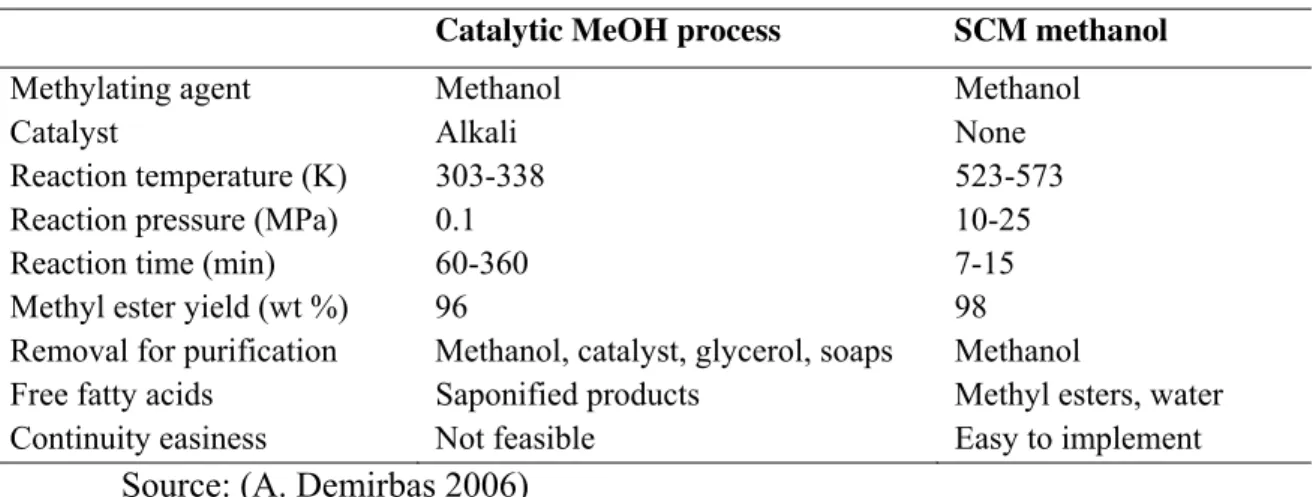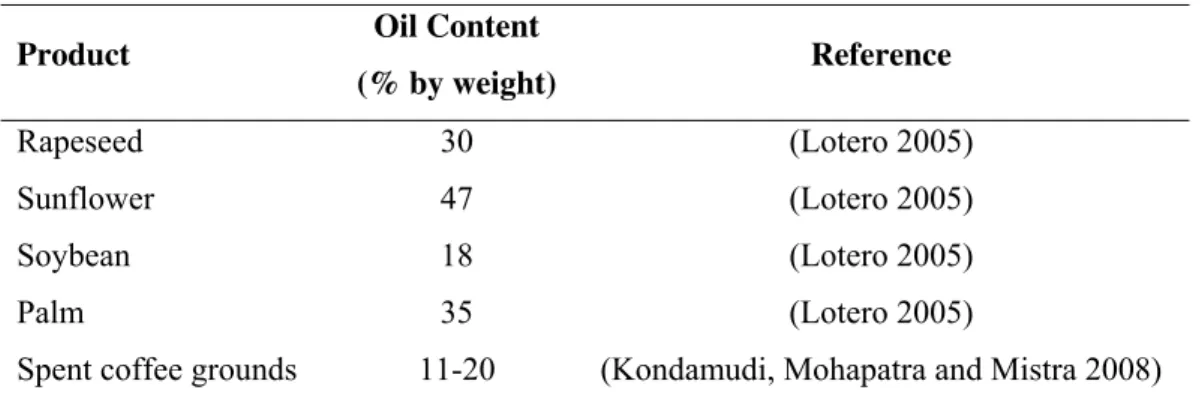Departamento de Química
Synthesis of biodiesel from wastes of food industry
via direct transesterification with methanol/carbon
dioxide mixtures
By
Filipe Miguel de Oliveira Calixto
Dissertation presented at Faculdade de Ciências e Tecnologia from Universidade Nova de Lisboa to obtain the degree of Master in Chemical and Biochemical Engineering
Supervisor: Professor Doutor Pedro Miguel Calado Simões
Co-ordinator: Professora Doutora Susana Filipe Barreiros
2
Acknowledgements
First I would like to thank my advisor, Professor Pedro Simões, who ploughed through several preliminary versions of my text, making critical suggestions and posing challenging questions. Special thanks to Ricardo Couto, João Fernandes and Pedro Lisboa, who was always willing to listen to new ideas and findings, discuss their relevance with me and make valuable suggestions.
Professor Marco Silva has also to be acknowledged for your help with GC in analytical part for this work.
I also thank some of my friends: Alex, Carlos, Filipe and Fábio. They helped make my lunches in FCT more fun and interesting.
“A person who never made a mistake never tried anything new”
4
Abstract
Direct transesterification with supercritical methanol of spent coffee ground oil in the temperature range of 523 to 603 K and in the pressure range of 15 to 30 MPa has been studied, and fatty acid methyl esters yield up to 85% were obtained. The percentage of oil contained in spent coffee grounds has been determined by soxhlet extraction with ethanol, resulting a value of 14% in oil.
Carbon dioxide as co-solvent was added to methanol with the aim of decreasing the operating temperature and pressure. In order to determine the optimal conditions of the various factors that influence the transesterification with CO2 in a minimum number
of experiments, the design of experiments (DOE) was applied. It was demonstrated that, at a reaction temperature of 573 K, pressure of 10 MPa and a molar ratio CO2/MeOH of
0.1 (optimal operation conditions), a 93% yield of methyl esters was obtained. The percentage in C16 (methyl palmitate) and C18 (methyl stearate, methyl oleate and methyl linoleate) has been determined in all samples. The C16 and C18 yields obtained in the experiment at 573 K, 10 MPa and a molar ratio CO2/MeOH of 10% were of
41.5% and 52%, respectively.
5
Resumo
Neste trabalho experimental estudou-se a transesterificação directa da borra de café com metanol supercrítico na gama de temperaturas entre 523 e 603 K e na gama de pressões entre 15 e 30 MPa, obtendo-se um rendimento máximo de ésteres metílicos de 85%. Foi também determinada a percentagem de óleo contida na borra de café através da extracção por etanol em soxhlet, resultando no valor de 14% em óleo.
Com a finalidade de fazer diminuir a temperatura e pressão de operação, adicionou-se ao metanol dióxido de carbono como co-solvente. Aplicou-se o desenho de experiências com o intuito de optimizar os parâmetros que influenciam a transesterificação com CO2, num número mínimo de experiências. Foi demonstrado que
à temperatura de reacção de 573 K, pressão de 10 MPa e na razão molar CO2/MeOH de
0.1 (condições óptimas de operação), o rendimento em ésteres metílicos foi de 93%. As percentagens de C16 (palmitato metílico) e de C18 (estearato metílico, oleato metílico e linoleato metílico) foram também determinadas em todas as amostras. Na experiência a 573 K, 10 MPa e razão molar CO2/MeOH de 10%, obteve-se um rendimento de C16 e
C18 de 41,5% e 52%, respectivamente.
6
Contents
Abstract ... 4
Keywords ... 4
Resumo ... 5
Palavras Chave ... 5
Contents ... 6
List of Figures ... 8
List of Tables ... 11
List of Abbreviations and Symbols ... 13
Introduction ... 15
Chapter 1 State of Art ... 16
1.1 Global energy: Overview ... 17
1.1.1 Fossil Fuels ... 17
1.1.2 Renewable Sources ... 18
1.2 Biodiesel ... 20
1.3 Transesterification of Vegetable Oils ... 24
1.3.1 Variables affecting transterification reaction ... 25
1.4 Supercritical Fluids ... 28
1.4.1 Supercritical Fluid Extraction ... 29
1.4.2 Transesterification in Supercritical Fluids ... 34
1.5 Direct Transesterification of spent coffee grounds oil in supercritical fluids ... 36
7
2.1 Materials ... 40
2.1.1 Chemicals ... 40
2.1.2 Equipment ... 41
2.1.3 Experimental set-up ... 42
2.2 Methods ... 44
2.2.1 Sample preparation and characterization ... 44
2.2.2 Direct Transesterification of spent coffee grounds oil in supercritical methanol ... 45
2.2.3 Direct Transesterification of spent coffee grounds oil in supercritical methanol/CO2 mixture ... 45
2.2.4 Evaporation of methanol in the sample ... 46
2.3 Sample analysis ... 46
Chapter 3 Results and Discussion ... 48
3.1 Direct transesterification in supercritical methanol ... 49
3.2 Direct transesterification from spent coffee grounds oil using supercritical methanol and CO2 as co-solvent ... 53
Chapter 4 Conclusions and Scope for Future Works ... 66
Chapter 5 References ... 69
Appendix ... 78
Appendix A – Experimental results... 79
Appendix B – ANOVA table of the design of the experiences ... 82
Appendix C – Replication of the best level ... 84
Appendix D – Calibration curves ... 85
8
List
of
Figures
Figure 1.1 – Annual Energy consumption values for selected countries ... 18
Figure 1.2 – Percent reduction in emissions of pollutants in B100 and B20. TH is total hydrocarbons, CO2 is carbon dioxide, CO is carbon monoxide, PM is particulate matter, NOx is nitrogen oxides, PHA is polycyclic hydrocarbons, and NPAH is nitrated PAHs. ... 21
Figure 1.3 – World edible oil production from the four most important oilseeds: rape, oil palm, soya and sunflower. ... 22
Figure 1.4- Overall transesterification reaction. ... 24
Figure 1.5 - Changes in yield percentage of methyl esters at different temperatures as a function of reaction time. Molar ratio of vegetable oil to methyl alcohol: 1:41. Sample: hazelnut kernel oil. ... 27
Figure 1.6 - Definition of supercritical state for a pure component. CP critical point, TP triple point, Tc critical temperature, Pc critical Pressure ... 28
Figure 2.1 – Apparatus for direct transesterification of spent coffee grounds oil in supercritical methanol and supercritical methanol/CO2 mixture. ... 42
Figure 2.2 – Soxhlet Extractor ... 44
Figure 2.3 – Saturated fatty acid methyl ester: methyl palmitate. ... 47
Figure 2.4 – Unsaturated fatty acid methyl ester: methyl oleate. ... 47
Figure 3.1 – Synthesis of spent coffee ground oil methyl esters, at various temperatures and pressures in supercritical methanol. : 523K and 15 MPa; : 553 K and 20 MPa; c: 583 K and 25 MPa; : 603 K and 30 MPa. Methyl flow rate was 0.5 ml/min. ... 49
Figure 3.2 – Yield of Triglycerides extracted but not converted in supercritical transesterification with methanol for different conditions of pressure and temperature. 50 Figure 3.3 – Yield of methyl esters converted from triglycerides in supercritical methanol for different conditions of pressure and temperature. ... 51
9
Figure 3.5 – Synthesis of spent coffee ground oil methyl esters, at various temperatures and pressures in supercritical methanol and CO2 as co-solvent. Molar ratio CO2/MeOH
was fixed at 10%. : 473 K and 10 MPa; : 473 K and 20 MPa; c:573 K and 10 MPa;
:573 K and 20MPa. ... 55
Figure 3.6 – Synthesis of spent coffee ground oil methyl esters, at various temperatures and pressures in supercritical methanol and CO2 as co-solvent. Molar ratio CO2/MeOH
was fixed at 30%. : 473 K and 10 MPa; : 473 K and 20 MPa; c: 573 K and 10 MPa; :573 K and 20 MPa. ... 55
Figure 3.7 – Synthesis of spent coffee ground oil methyl esters, at various temperatures and ratios CO2/MeOH in supercritical methanol and CO2 as co-solvent. Pressure was
fixed at 10MPa. : 473 K and 10%CO2; : 473 K and 30%CO2; c:573 K and
10%CO2; :573 K and 30%CO2. ... 56
Figure 3.8 – Synthesis of spent coffee ground oil methyl esters, at various temperatures and ratios CO2/MeOH in supercritical methanol and CO2 as co-solvent. Pressure was
fixed at 20MPa.: :473K and 10%CO2; :473K and 30%CO2; c: 573K and 10%CO2;
: 573K and 30%CO2. ... 56
Figure 3.9 – Synthesis of spent coffee ground oil methyl esters, at various pressures and ratios CO2/MeOH in supercritical methanol and CO2 as co-solvent. Temperature was
fixed at 473 K. : 10% CO2 and 10MPa; :10%CO2 and 20MPa; c:30%CO2 and
10MPa; : 30%CO2 and 20MPa. ... 57
Figure 3.10 - Synthesis of spent coffee ground oil methyl esters, at various pressures and ratios CO2/MeOH in supercritical methanol and CO2 as co-solvent.
Temperature was fixed at 573 K. : 10% CO2 and 10MPa; :10%CO2 and 20MPa;
c:30%CO2 and 10MPa; : 30%CO2 and 20MPa. ... 57
Figure 3.11 - Yield of Triglycerides extracted but not converted in supercritical transesterification with methanol and CO2 as co-solvent in different condition of
pressure and temperature. ... 59
Figure 3.12 – Yield of methyl esters converted from triglycerides in supercritical transesterification with methanol and CO2 as co-solvent in different condition of
pressure and temperature. ... 59
10
CO2/MeOH is 0.1) at 573 K and 10 MPa. C16, methyl palmitate; C18 methyl stearate,
methyl oleate and methyl linoleate. ... 60
Figure 3.14 – Mass Fraction of polar and non-polar part for several samples in direct transesterification with supercritical methanol and CO2 as co-solvent. ... 61
Figure 3.15 – Percentage of methyl esters estimated by STATISTICA7 software, varying the pressure and the ratio CO2/MeOH, at a constant temperature of 523 K. .... 62
Figure 3.16 – Percentage of methyl esters estimated by STATISTICA7 software, varying the temperature and the ratio CO2/MeOH, at a constant pressure of 15MPa. ... 63
Figure 3.17 – Percentage of methyl esters estimated by STATISTICA7 software, varying the pressure and the temperature, at a constant ratio CO2/methanol of 20%. ... 63
Figure 3.18 – Methyl Esters yield for the best essay at 573 K, 10 MPa and molar ratio CO2/MeOH of 10% and two replications. c: Experimental test; : Replica 1; :
Replica 2. ... 64
Figure 3.19 – Synthesis of spent coffee ground oil methyl esters, at various temperatures in supercritical methanol and CO2 as co-solvent. Carbon dioxide and
methanol were taken at a molar ratio of 10% with a constant pressure at 10 MPa. : 473 K; : 523 K; c:573 K. ... 65
Figure D. I – Calibration curve for Methyl Palmitate (C16) peaks in GC, equation of calculated trend line and its correlation coefficient. A(C16): peak area of Methyl Palmitate. ... 85
Figure D. II – Calibration curve for Methyl Stearate, Methyl Oleate and Methyl Linoleate (C18) peaks in GC, equation of calculated trend line and its correlation coefficient. A(C18): peak area of Methyl Stearate, Methyl Oleate and Methyl Linoleate. ... 85
11
List
of
Tables
Table 1.1 – Fatty acid distribution of some vegetable oils ... 23
Table 1.2 – Order of magnitude of physical properties (density, diffusion and viscosity) for gaseous, supercritical and liquid state. ... 29
Table 1.3 – Processing Parameters in the Extraction of Solids ... 33
Table 1.4 – Critical Temperatures and critical pressures of various alcohols ... 35
Table 1.5 – Comparison between catalytic methanol (MeOH) process and supercritical methanol (SCM) method for biodiesel from vegetable oils by transesterification ... 35
Table 1.6 – Oil content of “traditional” vegetable oils and spent coffee ground. ... 37
Table 1.7 – Comparison of Coffee Oil with Other Waste Feedstock for Biodiesel Production ... 37
Table 2.1 – All compounds used in this experimental work ... 40
Table 3.1 - Parameters studied to optimize of the direct transesterification of spent coffee ground oil using supercritical methanol and CO2 as co-solvent, according to the
DOE ... 53
Table 3.2 - Design of experiments (DOE) of transesterification from spent coffee grounds oil using supercritical methanol and CO2 as co-solvent ... 54
Table 3.3 – Yield of methyl esters for the best level and two replications for a molar ratio CO2/methanol of 10%, temperature of 573 K and pressure of 10 MPa. ... 64
Table A. I - Experimental data for direct transesterification of spent coffee grounds oil with supercritical methanol. ... 79
Table A. II - Methyl Esters formed and triglycerides extracted mass in supercritical transesterification with methanol in different condition of pressure and temperature. .. 79
Table A. III - Experimental data for direct transesterification of spent coffee grounds oil with supercritical methanol and CO2 as co-solvent at a molar ratio CO2/methanol of
12
Table A. IV - Experimental data for direct transesterification of spent coffee grounds oil with supercritical methanol and CO2 as co-solvent at a molar ratio CO2/methanol of
the 30%. ... 80
Table A. V – Methyl Esters formed and triglycerides extracted percentage in supercritical transesterification with methanol and CO2 as co-solvent in different condition of pressure and temperature, at a molar ratio CO2/methanol of 10 %. ... 81
Table A. VI - Methyl Esters formed and triglycerides extracted percentage in supercritical transesterification with methanol and CO2 as co-solvent in different condition of pressure and temperature, at a molar ratio CO2/methanol of 30 %. ... 81
Table B. I – ANOVA table given by STATISTICA7 software. ... 82
Table B. II – F Cumulative Probabilities: 95% confidence level (α = 0.05) ... 83
Table C I – Yield of methyl esters for the best level and its two replications. Molar ratio CO2/methanol of 10%, temperature of 573K and pressure of 10MPa ... 84
Table E I – Isobaric Properties for Methanol at 10 MPa ... 87
Table E II – Isobaric Properties for CO2 at 10MPa1 ... 87
Table E III – Isobaric Properties for Methanol at 20 MPa1 ... 87
13
List
of
Abbreviations
and
Symbols
B20 – 20 percent biodiesel and 80 percent petroleum B100 – 100 percent biodiesel
BPR – Back Pressure Regulator C16 – Methyl Palmitate
C18 - Methyl Stearate, Methyl Oleate and Methyl Linoleate CO2 – Carbone dioxide
FAAE – Fatty Acid Alkyl Esters FAME – Fatty Acid Methyl Esters FFA – Free Fatty Acid
FI – Flux Indicator
GC – Gas Chromatography
HPLC - High-performance liquid chromatography K - Kelvin
KOH – Potassium hydroxide KOMe - Potassium methoxide min. – minute
MeOH – Methanol MPa – Mega Pascal NA – Not Available NaOH – Sodium hydroxide NaOMe - Sodium methoxide NG – Natural Gas
PC – Critical pressure
PI – Pressure Indicator SC – Supercritical
SC-CO2 – Supercritical carbon dioxide;
14 TC – Critical temperature
TI – Temperature Indicator Wt% - weight percent
ν – Degree of freedom
15
Introduction
In recent times, the world has confronted the twin crises of fossil fuel depletion and environmental degradation. The indiscriminate exploration and consumption of fossil fuels has led to a reduction in petroleum reserves. Alternative fuels, energy conservation and management, energy efficiency and environmental protection have become important in recent years. From the point of view of global environment protection and the concern for long-term supplies of conventional diesel fuels, it becomes necessary to develop alternative fuels comparable with conventional fuels. Alternative fuels should be, not only sustainable but also environmentally friendly. A good diesel oil substitute is biodiesel
The work aimed to optimize the operating parameters affecting direct transesterification of spent coffee grounds in supercritical methanol with and without carbon dioxide as co-solvent. The source of spent coffee ground was the bar of the Chemistry Department building at FCT campus.
Initially, it made up the preparation and characterization of spent coffee grounds oil. Then it was optimized the temperature and pressure of direct transesterification with supercritical methanol. For this purpose some tests were made.
However, the synthesis of biodiesel by supercritical methanol has the drawback of using high temperature and pressure, which are not viable in industry. Thus, carbon dioxide was added into the reaction mixture with the aim of decreasing the operating temperature and pressure. In order to determine the optimal conditions of the various factors such as temperature, pressure and molar ratio of CO2/MeOH, in a minimum
number of experiments, the design of experiments was applied.
17
1.1
Global
energy:
Overview
1.1.1
Fossil
Fuels
The motivation behind the development and use of alternative fuels are mainly, the diminishing reserves of readily recoverable oil from fossil origin, the concern over global climate change, the increasing fuel prices and the desire for energy independence and security (Ueno, et al. 2001).
The major part of all the energy consumed worldwide comes from fossil like coal, petroleum and natural gas (NG), with the exception of hydroelectricity and nuclear energy, all these sources are finite and at the current usage rates will be consumed shortly. Petroleum-based fuels have limited reserves concentrated in specific regions of the world. These sources are in the verge of getting extinguished (A. Demirbas 2007).
Diesel fuels have an essential function in the industrial economy of a developing country and are used for transport of industrial and agricultural goods and operation of diesel tractor and pump sets in the agricultural sector. Economic growth is always accompanied by a commensurate increase in transports (Meher, Sagar and Naik 2004).
Figure 1.1 shows that, between 1985 and 2005, annual energy consumption increased 31 percent in the United States, while only 18 percent in Europe, and an overwhelming 250 percent in China and India.
18
Figure 1.1 – Annual Energy consumption values for selected countries1
1.1.2
Renewable
Sources
Renewable energy deriving from solar, wind, and biomass sources has great potential for growth to meet our future energy needs. Alternative new and renewable fuels have the potential to solve many of the current social problems and concerns, from air pollution and global warming to other environmental improvements and sustainability issues (Urbanchuk 2003).
There is a growing interest in the valorization of waste and by-products from agrochemical industries, not only by using them as alternative raw materials for different processes, but also as a means to reduce their environmental impact. The European Commission is taking measures to ensure that the target of 20 % renewable energy share of final energy consumption in 2020 will be met ( European Commission 2008).
1
19
Fuels such as ethanol, hydrogen, or biodiesel are characterized as biofuels because they can be produced by the activity of biological organisms and they can be used in the energy, food, and nutraceutical/pharmaceutical industries (Drapcho, Nhuam and Walker 2008). Biofuels are generally considered as offering many advantages, including sustainability, reduction of greenhouse gas emissions, regional development, social structure and security of supply (Reijnders 2006).
Biofuel production, if approached in a sustainable manner, can be more environmentally benign than fossil fuel technologies for several major reasons. First, biofuel production from biomass is largely carbon neutral –that is, the CO2 produced as
the fuel is combusted, is offset by the carbon absorbed as the biomass is grown (Tillman, Hill and Lehman 2006). Second, bioconversion processes in general do not produce hazardous compounds, and if toxic solvents and chemicals are avoided in the processing stages, then fewer environmental pollutants are produced. Third, biomass production and microbial conversion processes can be developed and used in a more distributed manner, avoiding the need for transport of fuels via cargo ships or pipelines for long distances (Drapcho, Nhuam and Walker 2008).
In developed countries there is a growing trend towards employing modern technologies and efficient bioenergy conversion using a range of biofuels, which are becoming cost-wise competitive with fossil fuels (Puhan, et al. 2005).
The scarcity of conventional fossil fuels, growing emissions of combustion generated pollutants and their increasing costs will make biomass sources more attractive (Sensoz, Angin and Yorgun 2000). On the other hand, biomass use, in which many people already have an interest, has the properties of being a biomass source and a carbon neutral source (Dowaki, et al. 2007).
20
1.2
Biodiesel
Recently, the world has been confronted with the twin crises of fossil fuel depletion and environmental degradation, particularly global warming (Sheehan, et al. 1998).A potential diesel oil substitute is biodiesel. Biodiesel consists of methyl esters of vegetable oils or animal fats and is produced by the transesterification reaction of triglycerides with short-chain alcohols, mainly methanol. The resulting biodiesel is quite similar to conventional diesel fuel in terms of their main characteristics (Meher, Vidya Sagar and Naik 2006).
Biodiesel has a viscosity similar to conventional petroleum diesel, moreover it is non-inflammable, and in contrast to petroleum diesel it is non-explosive, with a flash point of 423 K for biodiesel as compared to 337 K to petroleum diesel. Unlike petrodiesel, biodiesel is biodegradable and non-toxic, and it significantly reduces toxic and other emissions when burned as a fuel (A. Demirbas 2009).
Emissions resulting from the use of biodiesel in combustion engines are greatly reduced compared to conventional petroleum diesel fuels by up to 100 percent sulfur dioxide, 48 percent carbon monoxide, 47 percent particulate matter, 67 percent total unburned hydrocarbons, and up to 90 percent reduction in mutagenicity (Lotero 2005). In Figure1.2, it is shown the emission reductions for biodiesel B100 (100 % biodiesel) and B20 (20% biodiesel blend) compared to conventional petroleum diesel fuels.
Biodiesel is renewable and does not contribute to global warming due to the closed carbon cycle. A life cycle analysis of biodiesel showed that overall CO2
emissions were reduced by 78% compared with petroleum-based diesel fuel, which is considered the most important greenhouse gas in climatic models (Sheehan, et al. 1998). A variety of feedstocks can be used to produce biodiesel and these feedstocks can be divided into first and second generation feedstocks. First generation feedstocks refer to vegetable food oils like rape seed, palm, soybean or sunflower oil. However, second generation feedstocks consist of non-edible seed oils such as Jatropha curcas or castor oil and waste oils (A. Demirbas 2006).
21
Figure 1.2 – Percent reduction in emissions of pollutants in B100 and B20. TH is total hydrocarbons, CO2 is carbon dioxide, CO is carbon monoxide, PM is particulate
matter, NOx is nitrogen oxides, PHA is polycyclic hydrocarbons, and NPAH is
nitrated PAHs. 1
Chemically, oils and fats consist among other lipids of triglycerides, which are glycerides that are esterified with three fatty acids. These fatty acids may differ by the length of carbon chains, the number, orientation and position of double bonds in these chains (Meher, Vidya Sagar and Naik 2006).
Several types of vegetable oils can be used for the preparation of biodiesel. Figure 1.3 shows the world edible oil production from the four most important oilseeds: rape, oil palm, soya and sunflower. The fatty acid compositions of some common vegetable oils, and also of coffee oil, which was used as the feedstock for the production of biodiesel in this work, are given in Table 1.1.
22
Figure 1.3 – World edible oil production from the four most important oilseeds: rape, oil palm, soya and sunflower.1
The advantages of vegetable oils as diesel fuels are liquid nature-portability, higher heat content (about 88% of diesel fuel), their renewability, lower sulfur and aromatic contents and ready availability and biodegradability (A. Demirbas 2005).
Disadvantages of using vegetable oils for biodiesel are their relative lower energy content (8 % less than petroleum diesel), higher viscosity, lower volatility, reactivity of unsaturated hydrocarbons (oxidative stability) (A. Demirbas 2003).
Vegetable oil has too high a viscosity too high to be used in most existing Diesel engines as a straight replacement fuel oil. There are a number of ways to reduce the viscosity of the vegetable oil. Dilution, micro-emulsification, pyrolysis and transesterification are the four techniques applied to solve the problems encountered with the high fuel viscosity. One the most common methods to reduce oil viscosity in the biodiesel industry is called transesterification (Pinnarat and Savage 2008)
1
Source: (Heinrich 2009) 111.2 115.5
120.5 124.4
128.2 131.6 135.2 138.8 142.6
0,0 20,0 40,0 60,0 80,0 100,0 120,0 140,0 160,0
2007 2008 2009 2010 2011 2012 2013 2014 2015
Millio
n
metric
tonnes
23
Table 1.1 – Fatty acid distribution of some vegetable oils
Fatty acid distribution (% by weight)
Ref. Vegetable-based oil Palmitic
16:0 Palmitoleic 16:1 Stearic 18:0 Oleic 18:1 Linoleic 18:2 Linolenic
18:3 Others
Rape (canola) oil 3.5 - 0.9 64.4 22.3 8.2 0.7 1
Olive oil 9.2 0.8 3.4 80.4 4.5 0.6 1.1 1
Sunflower oil 6.0 - 4.2 18.7 69.3 - 1.8 1
Safflower oil 5.2 - 2.2 76.3 16.2 - 0.1 1
Soybean oil 10.6 - 4.8 22.5 52.3 8.2 1.6 1
Palm oil 47.9 - 4.2 37.0 9.1 0.3 1.5 1
Cottonseed oil 28.7 - 0.9 13.0 57.4 - - 2
Poppy seed oil 12.6 0.1 4.0 22.3 60.2 0.5 0.3 2
Sesame seed oil 13.1 - 3.9 52.8 30.2 - - 2
Linseed (flax) oil 5.1 0.3 2.5 18.9 18.1 55.1 - 2
Wheat grain oil 20.6 1.0 1.1 16.6 56.0 2.9 1.8 2
Corn oil 11.8 - 2.0 24.8 61.3 - 0.1 2
Peanut oil 11.4 - 2.4 48.3 32.0 0.9 5 2
Hazelnut oil 4.9 0.2 2.6 83.6 8.5 0.2 - 2
Walnut oil 7.2 0.2 1.9 18.5 56.0 16.2 - 2
Almond oil 6.5 0.5 1.4 70.7 20.0 - 0.9 2
Jatropha curcas 13.3 1.0 4.9 32.0 45.0 0.2 3.6 3
Rice bran oil 21.5 - 2.9 38.4 34.4 2.2 0.6 4
5
Coffee oil 38.7 0.7 7.5 9.0 35.9 3.1 5.1 6
1
Source: (Lotero 2005)
2
Source: (A. Demirbas 2003)
3
Source: (Tiwari, Kumar and Raheman 2007)
4
Source: (Xu and Godber 1999)
5
Green Coffee Arabica oil
6
24
1.3
Transesterification
of
Vegetable
Oils
Vegetable oils are made of triglycerides molecules, in which three fatty acid groups are esters attached to one glycerol molecule. The triglyceride molecules differ by the nature of the alkyl chain bound to glycerol. Transesterification is the process of reacting triglycerides with an alcohol in presence of a catalyst (e.g. a strong acid or a base) to produce a mixture of fatty acid alkyl esters (FAAE) and glycerol. It consists of a sequence of three consecutive reversible reactions where triglycerides are sequentially converted to diglycerides and these to monoglycerides and finally conversion of monoglycerides to FAAE and glycerol (Meher, Sagar and Naik 2004). Figure1.4 shows the overall reaction.
Figure 1.4- Overall transesterification reaction1.
1
25
The stoichiometric reaction requires 1 mol of a triglyceride and 3 moles of the alcohol, however, an excess of the alcohol is used to increase the yields of the alkyl esters and to allow its phase separation from the glycerol formed.
The transesterification reaction proceeds using primary or secondary monohydric aliphatic alcohols. Among them the most used in this reaction are methanol, ethanol, propanol, butanol and amyl alcohol. Methanol and ethanol are used frequently, but methanol is preferable because of its low cost and its physical and chemical advantages (polar and shortest chain alcohol) (A. Demirbas 2005). The transesterification reaction can be catalyzed by alkalis (Ramadhas, Jayaraj and Muraleedharan 2004), acids (Furuta, Matsuhashi and Arata 2004), or enzymes (Noureddini, Gao and Philkana 2005).
Acids used for transesterification include methanolic sulfur acid (Sahoo, et al. 2007), ferric sulfate (Wang, et al. 2007), methanolic hydrogen chloride (Darnoko and Cheryan 2000), methanolic boron trifluoride (Rule 1997) and sulfonic acid (Guerreiro, et al. 2006). Transesterification by acid catalysis is much slower than by alkali catalysis (A. Demirbas 2009).
Alkalis used for transesterification include NaOH or KOH (A. Demirbas 2009), Demirbas reported that the alkali-catalyzed transesterification proceeds much faster than that catalyzed by the same amount of an acidic catalyst and thus it is most often used commercially.
The enzyme-catalyzed transesterification processes are not yet commercially developed, new results have been reported in some articles (Shah, Sharma and Gupta 2004) (Noureddini, Gao and Philkana 2005) (Du, et al. 2004). The common aspects of these studies consist in optimizing the reaction conditions (solvent, temperature, pH, etc) in order to establish suitable characteristics for an industrial application. However, the reaction yields as well as the reaction times are still unfavorable compared to the base-catalyzed reaction systems (A. Demirbas 2008).
1.3.1
Variables
affecting
transterification
reaction
26
1.3.1.1
Effect
of
water
and
free
fatty
acids
(FFA)
The free fatty acid moisture content are key parameters for determining the viability of the vegetable oil transesterification process. To carry the base catalyzed reaction to completion; an free fatty acid value lower than 3% is needed. The higher the acidity of the oil, smaller is the conversion efficiency. Both, excess as well as insufficient amount of catalyst may cause soap formation (Meher, Sagar and Naik 2004). The resulting soaps can induce an increase in viscosity, formation of gels and foams, and make the separation of glycerol difficult (Ghadge and Raheman 2005).
The effects of free fatty acids and water on transesterification of beef tallow with methanol were investigated (Ma, Clements and Hanna 1998). The results showed that the water content of beef tallow should be kept below 0.06% w/w and FFA content of beef tallow should be kept below 0.5% w/w in order to get the best conversion.
Water content is an important factor in the conventional catalytic transesterification of vegetable oil. Free fatty acids and water always produce negative effects since the presence of FFA and water causes soap formation, consumes catalyst, and reduces catalyst effectiveness (A. Demirbas 2006).
1.3.1.2
Effect
of
molar
ratio
The molar ratio of alcohol to oil is one of the most important variables influencing the conversion of oil into alkyl esters, because excess alcohol shifts the reaction to product side. Ramadhas et al. (Ramadhas, Jayaraj and Muraleedharan 2004) and Sahoo et al. (Sahoo, et al. 2007), have reported a 6:1 molar ratio for acid esterification and a 9:1 molar ratio for alkaline esterification as the optimum values for biodiesel production from high FFA rubber seed oil and polanga seed oil, respectively. Veljkovic et al. (Veljkovic, et al. 2006) have achieved an 18:1 molar ratio during acid esterification and 6:1 molar ratio during alkaline esterification. Meher et al. (Meher, Vidya Sagar and Naik 2006) have taken 6:1 molar ratio during acid esterification and 12:1 molar ratio during alkaline esterification.
27
1.3.1.3
Effect
of
reaction
time
and
temperature
The conversion rate increases with reaction time. Ma et al. (Ma and Hanna 1999) studied the effect of reaction time on transesterification of beef tallow with methanol. The reaction was very slow during the first minute due to mixing and dispersion of methanol into beef tallow. From one to 5 min, the reaction proceeds very fast. The production of beef tallow methyl esters reached the maximum value about 15 min.
Transesterification can occur at different temperatures, depending on the oil used. For the transesterification of refined oil with methanol (6:1) and 1% NaOH, the reaction was studied at three different temperatures. After 0.1 h, ester yield were 9, 87 and 64% for 60, 45 and 32 ºC, respectively. After 1h, ester formation was identical for 60 and 45 ºC runs and only slightly lower for the 32 ºC run. Temperature clearly influenced the reaction rate and yield of esters (Ma and Hanna 1999).
Figure 1.5 shows a typical example of the relationship between the reaction time and the temperature (A. Demirbas 2009). As it can be seen, increasing the reaction temperature has a favorable influence on the yield of ester conversion.
28
1.4
Supercritical
Fluids
The supercritical state is achieved, when the temperature and pressure of a substance is raised over its critical values (critical temperature and critical pressure). The critical point represents the highest temperature and pressure at which the substance can exist as a vapor and liquid in equilibrium. This can be explained with reference to the phase diagram for pure component (Figure 1.6). The liquid becomes less dense because of thermal expansion and gas becomes denser as the pressure rises. Eventually the densities of the two phases become identical at the critical point. The fluid above this state is described as a supercritical fluid. In the supercritical state the distinction between the liquid and the gas phase has disappeared and liquid can no longer be liquefied by raising the pressure nor can gas be formed by increasing the temperature (Kamat, Beckman and Russel 1995).
Figure 1.6 - Definition of supercritical state for a pure component. CP critical point, TP triple point, Tc critical temperature, Pc critical Pressure1
Under supercritical conditions, the properties of the substance (e.g. density, viscosity, diffusion coefficient…) are intermediate between those of liquid and gas. The density is typically of the order of magnitude of liquid density (from 0.1 to 0.8 g cm-3). The solvating power of supercritical fluids is also very similar to the one of many conventional organic solvents and much higher than in gases. Moreover, the diffusion
1
29
coefficient of supercritical fluids is about 5 to 50 times higher than in liquids. This is illustrated in Table 1.2 (Brunner 2005).
Table 1.2 – Order of magnitude of physical properties (density, diffusion and viscosity) for gaseous, supercritical and liquid state.
Density Diffusion Viscosity
(g cm-3) (cm2 s-1) (g cm-1 s-1)
Gas 10-3 10-1 10-4
Supercritical fluid 10
-1
– 1 10-4 – 10-3 10-4 – 10-3
Liquid-like Liquid-like Gas-like
Liquid 1 <10-5 10-2
1.4.1Supercritical
Fluid
Extraction
Supercritical Fluid Extraction (SFE) is based on the fact that, near the critical point of the solvent, its properties change rapidly with only slight variations of pressure.
Supercritical fluids, as supercritical carbon dioxide, can be used to extract analytes from samples. The main advantages of using supercritical carbon dioxide for extractions is that it is inexpensive, extract the analytes faster and more environmentally friendly than organic solvents. For these reasons CO2 is the reagent widely used as
supercritical solvent (Kondamudi, Mohapatra and Mistra 2008).
Indeed, supercritical fluid extraction (SFE) has immediate advantages over traditional extraction techniques:
1. SCFs have solvating powers similar to liquid organic solvents, but with higher diffusivities, lower viscosity, and lower surface tension;
2. Since the solvating power can be adjusted by changing the pressure or temperature ,separation of analytes from solvent is fast and easy;
3. By adding modifiers to a SCF its polarity can be changed for having more selective separation power;
30
5. SCF technology requires sensitive process control, which is a challenge. In addition, the phase transition of the mixture of solutes and solvents has to be measured or predicted quite accurately.
Separation in a SFF process can occur in two different ways:
a) Separation by reducing solvent power (Bruno and Fly 1991):
i. Using an expansion chamber to expand the extraction phase to conditions where the solvent is sub-critical. A two-phase mixture is formed, consisting of the liquid solvent containing the extract and the remaining gaseous phase of the solvent. Extra costs are needed if recycling of the solvent is wanted;
ii. Coupling the extraction step with a pressure reduction separation, with no phase change. A pressure reduction leads to lower concentrations of the dissolved substances because of the lower density of the SCF. This solution also requires some extra cost due to the recompression of the solvent;
iii. To reduce cost in ii, an isobaric heating of the solvent can be used as a separation step. A higher temperature decreases the density of the solvent leading to a lower solvent power. But this increase also increases vapour pressure of the solute, so at low pressures (where density decreases strongly with temperature) it is possible to separate solutes from the SCF; at high pressures (where density decreases moderately with temperature) the opposite occurs and the gas phase is richer in solutes.
b) Separation of extract and solvent by a mass separating agent (Ruivo 2003): i. In certain cases the solutes processed into a SFE unit may be
31
ii. Like absorption, the adsorption separation allows to operate the circuit of the supercritical solvent at a constant pressure. Adsorption is very effective with respect to removing the extract from the gas and regenerating the gaseous solvent. This technique can be useful for solutes that do not need to be recovered after the extraction step, since it may be difficult to remove the extract from the adsorbents;
iii. Separation can also be achieved using membrane technology. Membranes allow the operation of the solvent circuit at low-pressure differences.
SFE of solids is the most studied application since the most frequently required separation process is the extraction/elimination of one or more compound families from a solid natural matrix (Reverchon and De Marco 2006). Some examples include the extraction of lipids from cyanobacteria (Mendes, Reis and Palavra 2006), extraction of essential oils from plants (Della Porta, et al. 1999), extraction of lycopene from tomatoes (Cadoni, et al. 2000) and the decaffeination of coffee (Zosel 1978). It has been carried out in a commercial scale for more than two decades, in processes like the decaffeination of coffee beans and black tea leaves and the production of hop extracts (Brunner 1994).
Parameters affecting the supercritical fluid extraction of solids are listed in Table1.3.
The influence of the process parameters can be summarized as follows (Martínez and Vance 2007):
• Solubility of compounds increase by increasing the extraction pressure at constant temperature;
32
• The separation conditions depend on the solubility of the compounds at different pressures and temperatures as well as whether a fractionation of extract is carried out by sequential depressurization steps. Generally the separation pressure is carried out at 5-6 MPa. For essential oils or volatile fractions, the separation takes place at 3 to 5 MPa and low temperatures to maximize the recovery of the top notes components. For oils, the separation can take place at 15 to 20 MPa due to their low solubility in supercritical carbon dioxide (CO2) under those conditions;
• The solvent-feed ratio depends on many factors, such as concentration of the solute in the feed material, solubility in the supercritical solvent, type of feed material, and distribution of the compound in the feed material;
• High solvent flow rates imply high operating and capital costs. However, they could increase production capacity. The solvent flow rate or the residence time of the solvent in the extraction vessel must be optimized. A high residence time implies a long batch time. Conversely, a short residence time may result in shorter contact time between the solvent and solute, resulting in a loading of the solvent much lower than the saturation concentration at the selected operating conditions;
• The size and morphology of the solid material have a direct effect on the mass transfer rate. In general, increasing the surface area increases the extraction rate. Therefore, smaller particle size or geometry (such as flakes) generally favors higher mass transfer, decreasing the batch time as well as diffusion controlled process. If the soluble substances are located in rigid structures inside of the solid matrix, the size reduction breaks this structure so it will be easily accessible for the solvent. However, very small particles favour a channelling effect, which decreases the extraction rate. Particle size needs to be evaluated case by case based on the type of material to be processed;
33
between 3% and 10% generally has no significant impact on the mass transfer of edible oil from seeds.
Table 1.3 – Processing Parameters in the Extraction of Solids 1
Raw Material Related
• Particle morphology and size
• Moisture
• Chemical reactions for setting free the extract compounds
• Cell destruction
• Pelletization
Operating Conditions
¾ Extraction conditions:
• Pressure
• Temperature
• Time
• Solvent flow
• Solvent-feed ratio
¾ Extraction operation:
• Fractional extraction
• Constant conditions
¾ Separation conditions:
• Pressure
• Temperature
¾ Separation operation:
• Single stage
• Fractional separation
The specialty oils rich in bio actives can be extracted from many plant sources. These extracted oils are mainly mixtures of triglycerides, free fatty acids, monoglycerides and diglycerides.
For seed oils, as well as biomass, SC-CO2 extraction is considered to be a
promising alternative to conventional processes of extraction, because SC-CO2 is non-toxic, non-flammable, non-corrosive, cheap, readily available, easily separable and environmental friendly (Sankar and Monohar 2000). Solubility is a strong function of
SC-CO2 density and the properties of the solute, such as molecular weight, polarity, and
vapour pressure. All lipid components of interest, especially oils, are soluble in SC-CO2
to different extents, depending on temperature and pressure conditions. Generally, solubility of lipids in SC-CO2 decreases with an increase in polarity and molecular
1
34
weight, thus following the order: fatty acid esters, fatty acids, and triglycerides (Güclü-Üstündag and Temelle 2004).
1.4.2
Transesterification
in
Supercritical
Fluids
Chemical reactions in supercritical fluids are considered as good candidates for new environmentally friendly technologies. The advantages to be gained by conducting reaction in supercritical fluids, apart from the environmental advantages, are as follows. First, there is control of phase behaviour to obtain homogeneity or separation as required. In second place, the increased diffusion can speed up the reactions, both homogeneous and heterogeneous, when diffusion is a controlling factor. Third, there is an enhanced control of reaction conditions, through both pressure and temperature (Afonso and Crespo 2005).
Current commercial production for biodiesel involves the use of alkali-catalyzed method (Khan, Warith and Luk 2007). In this method, however, those oils with high free fatty acid and water contents are difficult to be utilized since the former reacts with alkaline catalyst to form undesirable saponified products and the latter hinders the complete conversion. Furthermore, several purification processes are necessary to remove catalyst and saponified products (Xin, Imahara and Saka 2008). So, the transesterification of triglycerides by supercritical methanol (SCM), ethanol, propanol and butanol has proved to be the most promising process. Table 1.4 shows the critical temperatures and critical pressures of various alcohols.
Transesterification can occur at different temperatures and this variable influences the reaction rate and yield of esters, depending on the oil used. Figure 1.5 shows a typical example of the relationship between the reaction time and temperature. It is observed that increasing the reaction temperature, especially to supercritical temperatures, has a favourable influence on ester conversion (A. Demirbas 2002).
35
Table 1.4 – Critical Temperatures and critical pressures of various alcohols
Alcohol Critical temperature (K) Critical pressure (MPa)
Methanol 512.2 8.1
Ethanol 516.2 6.4
1-Propanol 537.2 5.1
1-Butanol 560.2 4.9
Source: (A. Demirbas 2002)
However, the synthesis of biodiesel by supercritical methanol has the drawback of the high cost of apparatus due to the high temperature and pressure, which are not viable in the large scale practice in industry. So, many researchers have focused on how to decrease the severity of the reaction conditions. Co-solvents, such as carbon dioxide (Han, Cao and Zhang 2005), hexane (Cao, Han and Zhang 2005) and calcium oxide (Dermirbas 2007), added into the reaction mixture can decrease the operating temperature, pressure and the amount of alcohol used (Yin, Xiao and Song 2007).
Table 1.5 – Comparison between catalytic methanol (MeOH) process and supercritical methanol (SCM) method for biodiesel from vegetable oils by transesterification
Catalytic MeOH process SCM methanol
Methylating agent Methanol Methanol
Catalyst Alkali None
Reaction temperature (K) 303-338 523-573
Reaction pressure (MPa) 0.1 10-25
Reaction time (min) 60-360 7-15
Methyl ester yield (wt %) 96 98
Removal for purification Methanol, catalyst, glycerol, soaps Methanol
Free fatty acids Saponified products Methyl esters, water
Continuity easiness Not feasible Easy to implement
36
1.5
Direct
Transesterification
of
spent
coffee
grounds
oil
in
supercritical
fluids
Coffee, together with tea, is one of the most popular drinks across the world. Its commercial and social importance is obvious. Coffee production is located mainly in South America, Brazil being the first producing country (42%). Africa and Asia account for 20.4% and 18.5%, respectively, of the total production. Yet, Europe is the main coffee consumer (Martín, et al. 2001).
Europe produces great amounts of agro-industrial residues, such as spent coffee grounds (SCG), which have largely been underexploited, most of them with detrimental effects on the environment. However, what used to be of little concern in the past is now a source of uneasiness, and strategies for tackling environmental issues while creating value are emerging. As with many other agro-industrial residues, SCG are vast resources of lipids, proteins and lignocellulosic materials and their valorization is receiving more attention (Kondamudi, Mohapatra and Mistra 2008). Conversion of lipids into biodiesel is a way to obtain economic profit from these renewable waste resources while contributing to the replacement of fossil fuels.
Spent coffee grounds contain in average up to 20wt% of lipids (87-93% of which are triglycerides), which may be converted into biodiesel, and also high added-value substances, such as tannins, with reported antioxidant and antihypertensive properties, among others (Farah and Donangelo 2006) (Arya and Rao 2007) (Ratnayake 1993) (Kondamudi, Mohapatra and Mistra 2008). According to other studies, it is estimated that 100g of roasted coffee beans originate ca.70g of SCG, on a dry weight basis (Pais 2006).
37
Table 1.6 – Oil content of “traditional” vegetable and spent coffee ground.
Product Oil Content
(% by weight) Reference
Rapeseed 30 (Lotero 2005)
Sunflower 47 (Lotero 2005)
Soybean 18 (Lotero 2005)
Palm 35 (Lotero 2005)
Spent coffee grounds 11-20 (Kondamudi, Mohapatra and Mistra 2008)
According with some sources, it is estimated that spent coffee grounds can potentially add 340 million gallons per year of biodiesel to the world’s fuel supply (Kondamudi, Mohapatra and Mistra 2008). According with these authors biodiesel from coffee grounds would be more stable than those from other sources because coffee contains antioxidants that would slow down degradation. Thus, the quality and cost-benefit of spent coffee ground are better as compared to other waste sources available as seen through Table 1.7.
Table 1.7 – Comparison of Coffee Oil with Other Waste Feedstock for Biodiesel Production.
Source Amount (million gallons/year) Advantage Disadvantage Animal fat Tallow, brown grease, pork fat (white grease), lard,
fish oil, poultry fat
5.51 Oxidative stability, less expensive
High sulfur content, high FFA (50-90%), bad odor, bad cold flow properties, high cloud point, high pour point,
transportation costs, purification required
Vegetable oil
Used vegetable oil 2.81 Less expensive, readily
available
Bad odor, high FFA
Waste coffee oil 2.92
Less expensive, higher stability, well-established transportation, pleasant smell
Extraction of oil from spent coffee grounds required
Source: (Kondamudi, Mohapatra and Mistra 2008)
1
38
Therefore, the present work aimed at an evaluation of the potential of using oil of waste coffee as a feedstock for biodiesel production. For this, it was made the extraction and transesterification of oil in a single step, using methanol and carbon dioxide as co-solvent in supercritical state. Preliminary studies have proven the viability of ScCO2 to extract oil from SCG (Simões, Couto and Fernandes 2009). Additional tests
40
2.1Materials
2.1.1Chemicals
The spent coffee ground (brand Tofa) used in all tests was provided by the bar of the Chemistry Department building at FCT campus. Furthermore, the other compounds are described in Table 2.1.
Table 2.1 – All compounds used in this experimental work.
Name Molecular formula Molecular mass
(g/mol) % purity Brand
Methanol for Chromatography CH4O 33.04 99.9 Sigma-Aldrich
Hexane for Chromatography C6H14 86.18 96 Merck
Carbone Dioxide CO2 44.01 99.98 AIR LIQUIDE
Ethylene Glycol C2H6O 62.07 NA Merck
Squalane C30H62 422.82 99 Aldrich
Methyl Palmitate C17H34O2 270.46 99 Sigma
Methyl Linoleate C19H34O2 294.72 99 Fluka
Methyl Stearate C19H38O2 298.51 96+ Aldrich
Methyl Oleate C19H36O2 286.49 99 Aldrich
41
2.1.2Equipment
The equipment used during the experimental work was the following: • Temperature and Process Controller CAL3300, model 312-1841; • Analytical balance METTLER TOLEDO, model PJ12;
• Circulator Bath HAAKE C1-W13; • PT100 sensor;
• internal thermocouple type K;
• HPLC – PUMP KNAUER, model K-501;
• Back Pressure Regulator (BPR) TESCOM, model 27-1700; • Gas Chromatography TRACEGC 2000 SERIES;
• Cryostat Julabo, model FT400; • LCD, Type NSI-33R;
• GC’s Oven Carlo Erba Strumentazione, model HRGC 5300 Series; • Flow controller Parker Pneumatic, model P3D;
• Oven Indelab, model 6882A;
42
2.1.3Experimental
set
up
Figure 2.1 – Apparatus for direct transesterification of spent coffee grounds oil in supercritical methanol and supercritical methanol/CO2 mixture.
The direct transesterification with methanol and methanol/carbon dioxide mixture apparatus is shown in Figure 2.1.
This apparatus is composed of a CO2 vessel, followed by a tank with
water/ethylene glycol (50:50 v/v), where it is immersed a cryostat (Julabo Immersion and Flow-through coolers, model FT400) and a circulator bath (Circulator Bath HAAKE C1-W13) to liquefy the carbon dioxide and allow it to be pumped by an HPLC – Pump (KNAUER, model K-501) through a packed bed reactor. The bath is at a temperature of -10 º C.
43
chromatographic oven (Carlo Erba Strumentazione, model HRGC 5300 Series) with temperature indicator and control.
A Back-pressure regulator (BPR) is located at the exit of the oven to control the pressure in the system. Pressure is measured by the HPLC – Pump internal sensor. Temperature is measured at the exit of the oven by an internal PT-100 sensor connected to a digital reader (CAL3300, model 312-1841).
At the end of the installation is placed a glass trap, with the purpose of collecting the formed products and to channel the CO2 for the exterior. The trap is immersed in an
44
2.2Methods
2.2.1Sample
preparation
and
characterization
Spent coffee grounds, collected from the chemistry department bar were dried at 353 K for five days in an oven (Indelab, model 6882A).
The percentage of oil contained in spent coffee grounds was obtained through soxhlet extraction with ethanol (Figure 2.2). In this method the sample is placed in a porous cellulose thimble. The thimble is placed in an extraction chamber (2), which is suspended above a flask containing the solvent (1) and below a condenser (3). Heating mantle was from Barnstead Electrothermal, model EM 1000. The boiling flask had a capacity of 1000 mL, and the extraction chamber was of 60 mL in volume.
Extraction was performed with ethanol as extraction solvent, and extraction temperature was 352 K (ethanol boiling point). The boiling flask is heated and the ethanol evaporates and moves up into the condenser where it condensed and trickle backs into the extraction chamber containing the sample. The extraction chamber is designed so that when the ethanol surrounding the sample exceeds a certain level it overflows and trickles back down into the boiling flask.
At the end of the extraction process, the flask containing ethanol and lipid is removed. The ethanol is then evaporated from the extracted oil in a rotary evaporator.
Figure 2.2 – Soxhlet Extractor
45
2.2.2Direct
Transesterification
of
spent
coffee
grounds
oil
in
supercritical
methanol
The process starts with weighing approximately 2 g of spent coffee. This sample is introduced in bed reactor a cylinder vessel with internal diameter of 20 mm and total length of 30 mm and closed with two metallic porous plates of 3 mm thickness each. The packed bed reactor is then introduced in the oven (Figure 2.1).
Following, the methanol is introduced in the reaction system before turning on the oven, to avoid the degradation of the spent coffee during heating. To avoid losses, the BPR valve (Tescom 27-1700) is gradually regulated as the temperature increases, since the pressure of methanol increases with temperature. When the desired temperature is reached, methanol is pumped into the circuit through the liquid pump (LCD, Type NSI-33R) with a flow rate of 0.5 mL/min.
The first experiment was done at 523 K and 15 MPa, the other experiences were conducted at temperatures of 553, 583 and 603K for pressures of 20, 25 and 30 MPa, respectively. A yellow/brown to dark brown viscous solution was obtained in the various traps, being each trap immersed in ice baths. Each trap is changed every 10 minutes during 50 minutes. The zero time of a experience begins when the first drop falls in the trap.
2.2.3Direct
Transesterification
of
spent
coffee
grounds
oil
in
supercritical
methanol/CO
2mixture
The process of direct transesterification of spent coffee grounds oil in supercritical methanol/CO2 mixture begins the same way as the process described in
point 2.2.2 and as shown in Figure 2.1. In this process, the carbon dioxide is introduced in the system before turning on the oven, to avoid the degradation of the spent coffee during heating. When the operating temperature is reached, CO2 is pumped into the
system through the HPLC pump (KNAUER, model K-501). Following the BPR (Tescom 27-1700) is gradually regulated until the operation pressure is reached.
46
The direct transesterification of spent coffee ground oil in supercritical methanol and CO2 as co-solvent was conducted in the range of temperatures of 473-573 K,
pressure range of 10-20 MPa and molar ratio CO2/ MeOH range of 10-30%. Collection
of samples in this method is similar to that described in point 2.2.2. Solutions obtained from the supercritical fluid reaction of the spent coffee were analysed by Gas Chromatography (GC), both qualitatively and quantitatively, for their content in methyl esters and triglycerides.
2.2.4Evaporation
of
methanol
in
the
sample
After the experimental run, the five collected samples were weighed in an analytical balance (METTLER TOLEDO, model PJ12).
The evaporation of methanol from the samples is performed by bubbling air into the collected samples. The air stream first passes through a molecular sieves packed bed in order to remove the moisture from the air and then by a flow regulator (Parker Pneumatic, model P3D) that regulates the flow of air that goes directly into the sample.
After complete evaporation of methanol, the final sample is weighed. Next, the sample was dissolved in 5ml of a solution of hexane with squalane in a concentration of 300mg/L. Squalane was used as internal standard for the sample analysis. However, the sample was not completely dissolved in hexane because it has a polar and a non-polar fraction.
The non-polar fraction was transferred to another vial, followed by evaporation of residual hexane. The polar fraction was weighted in an analytical balance (METTLER TOLEDO, model PJ12) and dissolved in 5mL of Methanol.
2.3Sample
analysis
47
O
O CH3 C
H3
Figure 2.3 – Saturated fatty acid methyl ester: methyl palmitate.
If they are unsaturated, the difference is that they have double bonds along the carbon chain (Figure 2.4).
O
O CH3
C H3
Figure 2.4 – Unsaturated fatty acid methyl ester: methyl oleate.
The npolar sample in Hexane with Squalane (1:100 v/v) was used for on-column injection in chromatograph.
The chromatograph was a Trace GC 2000 Series with a flame ionization detector (FID); a ZB-5HT Inferno column, 10 m × 0.25 mm and 0.10 μm film thickness, from Zebron was used. This the column stationary phase being non-polar the methyl esters are separated due to their boiling points, and the unsaturated compounds are eluted before the corresponding saturated acids of the same chain length. For the samples under study, this column allows simultaneous determination of triglycerides and methyl esters in the sample. However, it was observed the occurrence of some overlapping of the methyl ester peaks corresponding to the methyl oleate, methyl stearate and methyl linoleate.
Hydrogen was used as carrier-gas .The flow starts with 0.1 ml.min-1 during 1 minute and rises with the rate 1.5 ml.min-1.min-1 to 1.1 ml.min-1 standing in this flow until the final of injection.
49
3.1
Direct
transesterification
in
supercritical
methanol
The direct transesterification of spent coffee ground oil in supercritical methanol was conducted in the range of temperatures of 523-603 K and pressures of 15-30 MPa. The critical temperature and pressure of methanol is 513 K and 8.1 MPa (Yin, Xiao and Song 2007).
To evaluate the effect of temperature and pressure in the transesterification of methyl esters using only methanol in the supercritical state, the curves presented in Figure 3.1 were obtained, which relate the yield of formation of methyl esters over time for the different conditions tested. These curves are built using the cumulative formation of methyl esters at each time of reaction, which means that when the curves reach a plateau, no more methyl esters are being formed and the reaction has reached its end. The yield of methyl esters formed was calculated taking into account the stoichiometry of the reaction and considering the percentage of oil contained in coffee ground to be 14% in weight. This percentage was obtained through soxhlet extraction with ethanol for the same spent coffee ground used in the various experimental runs. The experimental results are presented in table A-I, in appendix A. The methanol flow rate was kept constant in the whole set of experiments, at 0.5 ml/min.
Figure 3.1 – Synthesis of spent coffee ground oil methyl esters, at various temperatures and pressures in supercritical methanol. : 523K and 15 MPa; : 553 K and 20 MPa;
c: 583 K and 25 MPa; : 603 K and 30 MPa. Methyl flow rate was 0.5 ml/min.
0 10 20 30 40 50 60 70 80 90 100
0 5 10 15 20 25 30 35 40 45
Methyl Esters, %
50
According with Figure 3.1, increasing temperature and pressure had a favorable influence on methyl ester yield. For experimental conditions of 603 K and 30 MPa, a high formation of methyl esters is obtained with a yield of 85% in 40 minutes.
The various samples have different yields of methyl esters and triglycerides. The amount of triglycerides extracted but not converted in different operating conditions is present in Figure 3.2. However, the yields of different methyl esters converted from the triglycerides extracted as a function of the operating conditions are indicated in Figure 3.3 (see also Table A-II in Appendix A). These figures show the total yields after 50 minutes of reaction, in the different conditions of pressure and temperature.
The triglycerides are not differentiated because there were no standards for all the triglycerides present in the oil of the spent coffee ground but only the tripalmitolein (C16:1) standard. This standard was used to build the calibration curve (see in Figure III–D in Appendix D) of triglycerides and to quantify all triglycerides in several samples. Methyl stearate, methyl oleate and methyl linoleate (C18) are presented together because the GC with injection on-Column could not separate the peaks.
Figure 3.2 – Yield of Triglycerides extracted but not converted in supercritical transesterification with methanol for different conditions of pressure and temperature. 5.7 2.0 0.7 0.4 0 1 2 3 4 5 6 7 8
1 2 3 4
Tryglicerides,
%
T = 523 K P = 15 MPa
T = 553 K P = 20 MPa
T = 583 K P = 25 MPa
51
Figure 3.3 – Yield of methyl esters converted from triglycerides in supercritical methanol for different conditions of pressure and temperature.
Figure 3.3 show that methyl palmitate (C16) yield increases with increasing temperature and pressure. The same is true for C18, except for the highest temperature and pressure (583 K and 25 MPa), in which yield is constant at 51%.
These results are in accordance with Saka and Dadan (Saka and Dadan 2001), which show of that increasing the reaction temperature, especially for supercritical conditions, has a favorable influence on the yield of ester conversion and accelerates the reaction.
This occurs because high reaction yields could be expected when only the vapor
phase is present and when the pressure and temperature correspond to a low density of
supercritical methanol. Low density, supercritical methanol is characterized by a
structure dominantly composed of the non-hydrogen bonded small species and a high
density methanol is characterized by large molecular aggregates (Glisic, et al. 2007).
Although the increase in pressure raises the density of supercritical methanol, this effect
is offset by the increase of temperature because the raise in temperature decreases the
density of supercritical methanol. However, as described in the section 2.2.2 of this thesis, in this process it is not possible to increase the temperature, while keeping the pressure constant. 15.1% 19.6% 29.6% 34.2% 23.7% 30.1% 51.0% 50.6% 0% 10% 20% 30% 40% 50% 60%
1 2 3 4
% C16 - Methyl Palmitate (C16:1)
% C18 - Methyl Stearate (C18:0), Methyl Oleate (C18:1) and Methyl Linolenate (C18:3)
T = 523 K P = 15 MPa
T = 553 K P = 20 MPa
T = 583 K P = 25 MPa
